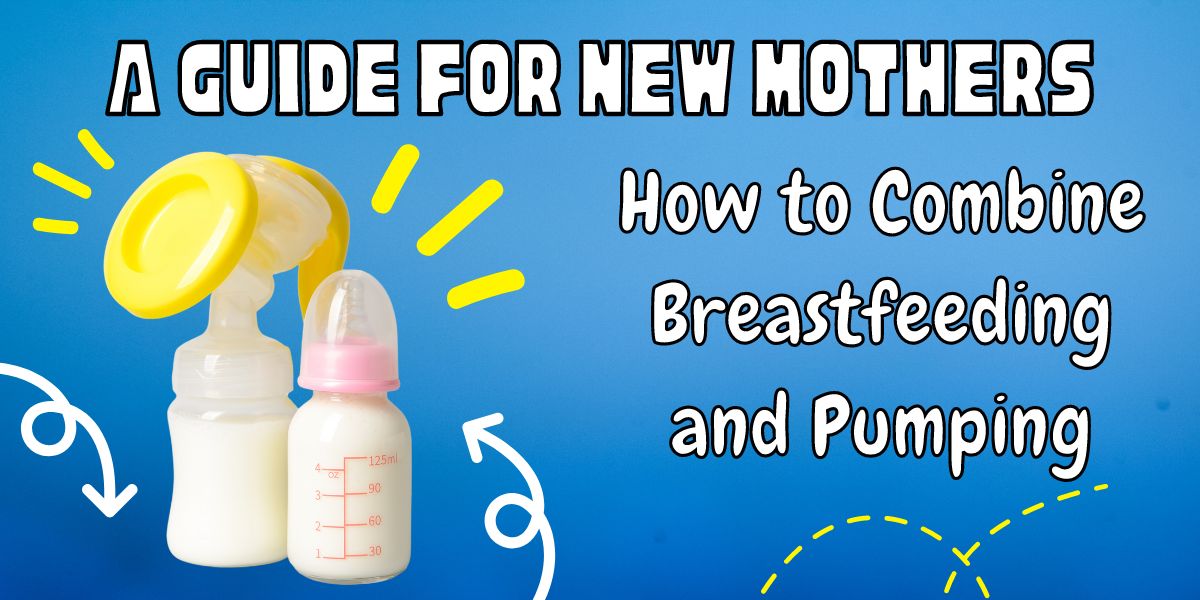For new moms, breastfeeding is a beautiful but sometimes challenging experience. Combining breastfeeding with pumping offers flexibility, freedom, and ensures your baby always has access to your milk. Whether you’re returning to work, managing supply issues, or simply need a break, this guide will help you find balance and success in your breastfeeding and pumping journey.
Creating a Breastfeeding and Pumping Schedule

- Start Early: Introduce pumping within a few weeks after birth to establish a good milk supply. Begin with one pumping session each morning when milk supply tends to be highest.
- Stay Consistent: Pump around the same time each day to help your body maintain a steady supply. Consider your baby’s feeding schedule and plan to pump right after a regular feeding or in between meals to keep up your supply without impacting breastfeeding times.
- Monitor Baby’s Needs: Be flexible and adjust your schedule based on your baby’s growth spurts and changing needs.
Preparing for a Successful Pumping Session

- Choose the Right Pump: Whether manual or electric, find a breast pump that suits your specific needs and lifestyle. Many women find a double electric pump saves time and stimulates milk production effectively.
- Find Your Space: Locate a comfortable, private space where you can relax during pumping sessions. Stress can hinder milk flow, so finding a calm environment is key.
- Stay Hydrated and Nourished: Drinking plenty of water and eating balanced meals can help maintain your milk supply.
Storing and Handling Breast Milk Safely

- Storage Containers: Use clean, sterilized bottles or bags designed for breast milk. Leave some space at the top as milk expands when frozen.
- Temperature Guidelines: Freshly pumped milk can stay at room temperature for up to 4 hours, in the refrigerator for up to 4 days, and in the freezer for about 6 months.
- Labeling: Always label your milk with the date it was expressed. Use the oldest milk first to ensure it’s used within a safe timeframe.
Maintaining Milk Supply

- Frequent Pumping: If you’re away from your baby or skipping feedings, pump as often as your baby would normally eat to maintain your supply and prevent engorgement.
- Balanced Diet: Consume a healthy diet rich in nutrients. Certain foods like oats, almonds, and spinach can potentially boost milk production.
- Rest and Relax: Adequate sleep and low stress levels can positively impact your milk supply.
Transitioning from Exclusive Pumping to Breastfeeding

- Take It Slow: Gradually increase breastfeeding sessions while decreasing pumping sessions to help your baby adjust.
- Use a Nipple Shield: If your baby struggles to latch, a nipple shield can ease the transition from bottle to breast.
- Seek Support: Lactation consultants can offer invaluable guidance during this transition.
How to Combine Breastfeeding and Pumping:
Combining pumping and breastfeeding can be an effective strategy for ensuring your baby receives the benefits of breastmilk even when you’re apart, while also allowing others to participate in feeding. Here are steps to seamlessly integrate both methods:
- Introduce a Bottle Early: To avoid nipple confusion, introduce a bottle after breastfeeding has been well established, typically around 3 to 4 weeks old. This helps your baby become accustomed to both breast and bottle feeding.
- Mimic Baby’s Feeding Schedule: When you’re away and pumping, try to pump around the same times your baby would normally feed. This keeps your milk supply in tune with your baby’s needs and maintains a routine.
- Use Pumped Milk for Missed Feedings: If you’re away from your baby during a normal feeding time, use the milk you’ve pumped to ensure your baby can still enjoy the benefits of your breastmilk. This can also help prevent overfill and discomfort for you.
- Practice “Paced Bottle Feeding”: When someone else is feeding your baby with a bottle, encourage them to use a technique called “paced bottle feeding.” This method mimics breastfeeding and helps prevent your baby from developing a preference for the bottle, which might lead to rejecting the breast due to the different suckling techniques required.
- Rotating Feeding Roles: If possible, rotate who feeds the baby with a bottle. This can help the baby become more adaptable to receiving milk in different ways and from different people, making the combination of breastfeeding and bottle feeding smoother for both baby and mother.
- Prioritize Direct Breastfeeding When Together: To maintain the breastfeeding bond and ensure efficient milk removal, prioritize direct breastfeeding whenever you’re with your baby. This not only supports your supply but also reinforces the baby’s ability to latch and feed efficiently.
By following these steps, you can create a flexible feeding routine that incorporates both pumping and breastfeeding, allowing you to maintain a strong milk supply while also giving your baby all the benefits of your breastmilk even when you’re not together.
Common Challenges and Troubleshooting

- Low Supply: Increase pumping frequency, ensure you’re hydrated and well-fed, and consider consulting a lactation specialist.
- Nipple Confusion: Introduce a bottle only after breastfeeding is well established to reduce confusion.
- Discomfort While Pumping: Adjust the pump settings and ensure the breast shield fits properly.
Conclusion:
Combining breastfeeding with pumping can empower you to meet the demands of motherhood on your terms. Remember, every mother’s journey is unique, and what works for one may not work for another. Be patient with yourself, seek support when needed, and celebrate the small victories. You’re doing an incredible job providing for your baby, and every effort counts.
To all the new mothers navigating this path – you are not alone, and you are more capable than you realize. Trust in your body, your baby, and the strength of the bond you share.
You might also be interested in:
Breastfeeding Tips for New Moms: How to Make Nursing Easier
The Truth About Pacifiers: The Risks and Impact on Your Baby

